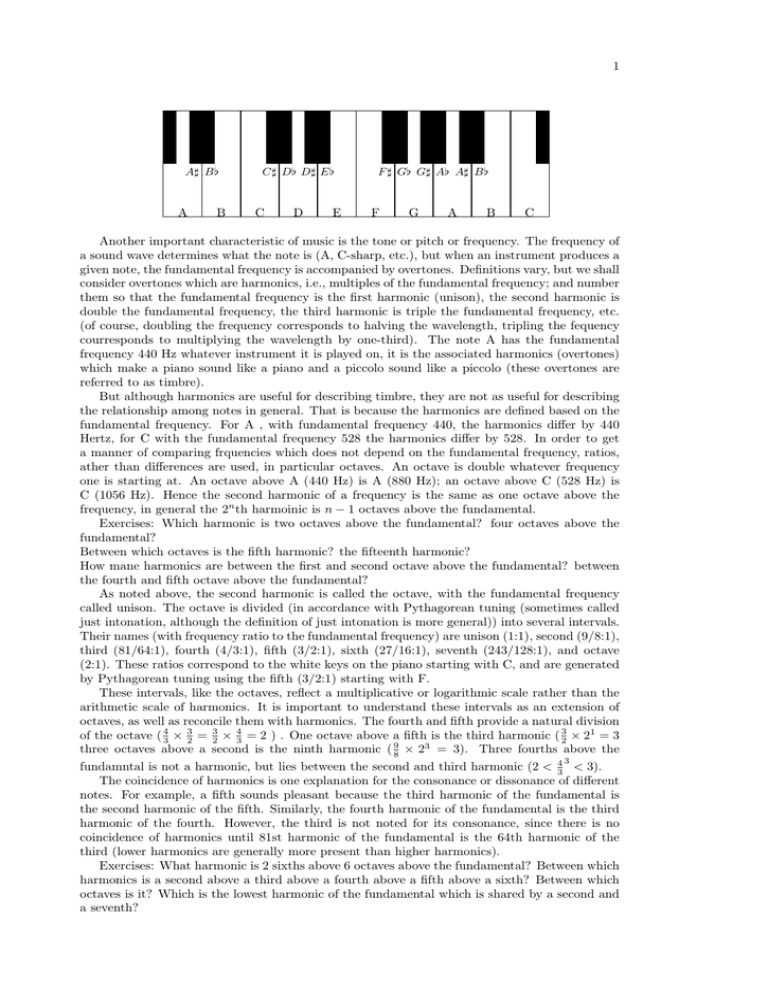1 A B C D E F G A B C Another important characteristic of music is
advertisement

1 A] B[ A B C] D[ D] E[ C D E F ] G[ G] A[ A] B[ F G A B C Another important characteristic of music is the tone or pitch or frequency. The frequency of a sound wave determines what the note is (A, C-sharp, etc.), but when an instrument produces a given note, the fundamental frequency is accompanied by overtones. Definitions vary, but we shall consider overtones which are harmonics, i.e., multiples of the fundamental frequency; and number them so that the fundamental frequency is the first harmonic (unison), the second harmonic is double the fundamental frequency, the third harmonic is triple the fundamental frequency, etc. (of course, doubling the frequency corresponds to halving the wavelength, tripling the fequency courresponds to multiplying the wavelength by one-third). The note A has the fundamental frequency 440 Hz whatever instrument it is played on, it is the associated harmonics (overtones) which make a piano sound like a piano and a piccolo sound like a piccolo (these overtones are referred to as timbre). But although harmonics are useful for describing timbre, they are not as useful for describing the relationship among notes in general. That is because the harmonics are defined based on the fundamental frequency. For A , with fundamental frequency 440, the harmonics differ by 440 Hertz, for C with the fundamental frequency 528 the harmonics differ by 528. In order to get a manner of comparing frquencies which does not depend on the fundamental frequency, ratios, ather than differences are used, in particular octaves. An octave is double whatever frequency one is starting at. An octave above A (440 Hz) is A (880 Hz); an octave above C (528 Hz) is C (1056 Hz). Hence the second harmonic of a frequency is the same as one octave above the frequency, in general the 2n th harmoinic is n − 1 octaves above the fundamental. Exercises: Which harmonic is two octaves above the fundamental? four octaves above the fundamental? Between which octaves is the fifth harmonic? the fifteenth harmonic? How mane harmonics are between the first and second octave above the fundamental? between the fourth and fifth octave above the fundamental? As noted above, the second harmonic is called the octave, with the fundamental frequency called unison. The octave is divided (in accordance with Pythagorean tuning (sometimes called just intonation, although the definition of just intonation is more general)) into several intervals. Their names (with frequency ratio to the fundamental frequency) are unison (1:1), second (9/8:1), third (81/64:1), fourth (4/3:1), fifth (3/2:1), sixth (27/16:1), seventh (243/128:1), and octave (2:1). These ratios correspond to the white keys on the piano starting with C, and are generated by Pythagorean tuning using the fifth (3/2:1) starting with F. These intervals, like the octaves, reflect a multiplicative or logarithmic scale rather than the arithmetic scale of harmonics. It is important to understand these intervals as an extension of octaves, as well as reconcile them with harmonics. The fourth and fifth provide a natural division of the octave ( 43 × 32 = 32 × 43 = 2 ) . One octave above a fifth is the third harmonic ( 32 × 21 = 3 three octaves above a second is the ninth harmonic ( 89 × 23 = 3). Three fourths above the 3 fundamntal is not a harmonic, but lies between the second and third harmonic (2 < 43 < 3). The coincidence of harmonics is one explanation for the consonance or dissonance of different notes. For example, a fifth sounds pleasant because the third harmonic of the fundamental is the second harmonic of the fifth. Similarly, the fourth harmonic of the fundamental is the third harmonic of the fourth. However, the third is not noted for its consonance, since there is no coincidence of harmonics until 81st harmonic of the fundamental is the 64th harmonic of the third (lower harmonics are generally more present than higher harmonics). Exercises: What harmonic is 2 sixths above 6 octaves above the fundamental? Between which harmonics is a second above a third above a fourth above a fifth above a sixth? Between which octaves is it? Which is the lowest harmonic of the fundamental which is shared by a second and a seventh?





